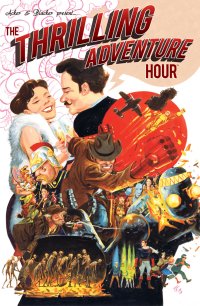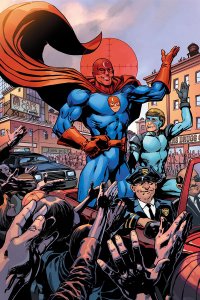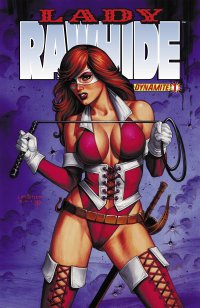Trillium #1 (Vertigo, $2.99)
by D.S. Randlett (@dsrandlett)
“We owe a cock to Aesclepius.” Socrates, apparently, spoke these words to a gathering of his students shortly before drinking the hemlock. Aesclepius was a god of healing, and hemlock a poisonous herbal drink given to those sentenced to death. Why, as he was getting ready to die for his numerous impieties, would Socrates offer sacrifice to a healing god in which he likely did not believe? If you really want the answer to this question, you are free to spend a few years reading Plato’s Phaedo and not come to one at your leisure, but within that question is the troubling assertion that life itself is something that needs a cure.
It’s the year 3797, and a mysterious and possibly sentient virus known as The Caul is in the process of wiping out mankind’s interstellar colonies, leaving only four thousand current survivors. The only defense against the disease is an equally mysterious flower, which is guarded by a race of aliens who hold it sacred. A young woman is tasked with learning to communicate with this civilization, and ends up getting more than she bargained for. It is also 1921. A young English veteran of The Great War cannot shake visions of mutilated corpses, explosions and mustard gas. Growing increasingly distant from his family and wife, he becomes fascinated by the culture of the Incas and decides to launch an ill-fated expedition to a lost temple.
Trillium has been described by writer/artist Jeff Lemire as “the last love story.” This first issue, then, presents us with the universe’s most impossible meet-cute. Which is kind of a pithy way of describing it. More seriously, this appears to be the beginning of a story of two people meeting amidst their own personal apocalypses, to say nothing of the way in which their respective worlds. The female scientist struggles with holding onto her memories of her mother, which her superiors seek to redefine, as well as the task of saving the last remnants of humanity. The male soldier is seeking for a way to, if not heal his fractured soul, to at least not feel his losses so intensely. Not to mention that in little more than a decade, his own world is about to be torn apart. In both cases we see their respective cultures attempting to suppress their individual needs and ways of thinking. Therein lies the real appeal of apocalyptic fiction, usually popular in times of crisis and duress, when we must all live, like Lemire’s scientist, “for the mission.” With such stories, we seem to want to ask ourselves if it would be better if everything just collapsed and we could once again breathe free. Trillium seems to be calling that mode of thought out as a fallacy. It seeks to ask: is there a better way of holding on? Is there a cure to all of this?
The past year or so has seen Jeff Lemire take on some adventure stories, like Time Warp’s short Rip Hunter story, or an issue of the digital only Adventures of Superman. I suspect that he’s not so interested in capturing brawn or power, as his depictions of superheroes and T-Rexes just never felt quite right. He seems to be more interested in frailty, in the sense that things might break at any time. This is true of the desperate future-humans of 3797 and the broken soldier of 1921. He invests an entire culture with a feeling of usedness, and with it a sense of tenacity. The same can be said of the man from the past. It must also be said that these portrayals never feel like caricatures of the feelings that Lemire intends to evokes, but rather the results of their particular contexts. When violence erupts, it is shocking, with the effect of watching priceless vases crash to the floor, equally due to the fragility of the linework and the delicate milkiness of the colors.
In short, Trillium is unique for its cohesive vision, but it’s also filled with really fun genre ideas and an emotional milieu that rings true. Socrates posited that his cure was the hemlock, and thus death. Trillium seems to say that we might be able to do better than that, but we won’t really know until issue 8. Strongly recommended.
Rating: 




Out of a Possible 5 Stars
 The Thrilling Adventure Hour HC (Archaia, $19.95)
The Thrilling Adventure Hour HC (Archaia, $19.95)
by Graig Kent
Over the past few years of reviewing comics I’ve developed a bit of prejudice towards the anthology, particularly as review fodder since it’s often frustrating to write both concisely and thoroughly about such a collection of short stories. Beyond that, I find anthologies to be generally expensive and a mix-bag in terms of quality and/or appeal. As well, within the anthology are typically stories unsatisfying as well as largely unmemorable, which isn’t to say that short stories or experimentation in form are without merit, but by and large the balance of thoroughly interesting or enjoyable material and the rest is quite off. I have embraced my genuine dislike for the form and have avoided most anthologies, even those I have a heavy interest in.
There’s one exception that I recognize, however, and often seek out. The humour anthology is always welcome. It’s possibly from being raised on a diet of Mad Magazine in my pre-teens, but a humour anthology is, really, the comics equivalent of sketch comedy, and I love sketch. Good sketch will often entertain no matter the length, which is why the funny pages have been such a staple in the newspaper (ignoring the dreck that most of them are), and a single memorable punchline can often make an entire collection worthwhile.
From Archaia, by way of Kickstarter, comes The Thrilling Adventure Hour, an anthology of comedic adventure tales spanning all the expected genres, based off the stage show/podcast of the same name created by Ben Acker and Ben Blacker. Though I’m an avid comedy podcast listener, perhaps my bona fides will be revoked if I admit to never having listened to the TAH. To my understanding it’s a live read of a fully scripted adventure done in the style of a 1930’s radio serial. The first ever podcast-to-comic adaptation (I’ll hazard a guess) this is a comic book translation of ten of TAH‘s regular features including: “Sparks Nevada, Marshal on Mars”; “Down in Moonshine Holler”; and “Captain Lazerbeam”. If you’ve never heard the show (or been to a live performance) then doubtless these names mean very little, though still providing a rudimentary hint at their satiric nature. Conversely, I’m sure if you are a fan of the program these visualizations will prove enticing and delightful.
Stepping into Acker and Blacker’s world, you’re first greeted with a classy Tom Fowler character collage cover, in the vein of classic cinema posters, as well as a title page, table of contents and introductions (by Patton Oswalt and Ed Brubaker) which are impeccably designed to look olde timey and ornate. Though it inspires confidence that the book will truly capture a 1930’s adventure-esque feel, there was a nagging doubt that being a newcomer to these characters and the TAH ouevre would be a barrier not easily overcome. The first such adventure, “Sparks Nevada” (with marvelous Kyle Baker-esque cartooning from Randy Bishop) thrusts you headlong into the TAH pool and it takes a bit of adjustment. A play on both westerns and Edgar Rice Burroughs-like science-fantasy, the rhythm of “Sparks Nevada” never seems to get foothold, with Acker and Blacker’s script finding the adjustment to comics medium a challenge. The dialogue seems to be written to be performed, spoken in layers so as to have the characters speaking over each other or in rapid pace, but it’s not entirely effective on the page. There’s a dynamic between these characters and a rhythm to their dialogue that would likely work better for the reader already familiar with them. At the same time, despite Bishop’s high quality visuals, there are gaps in the panel flow, which makes for a bit of a choppy read.
Thankfully, things only improve from there. “Philip Fathom: Deep Sea Detective” (art by Jeff Stokely) blends hard boiled crime stories with dour mermen and birthday parties to highly amusing effect, followed by the rollicking “Cross-Time Adventures of Colonel Tick-Tock” (art by Chris Moreno) which finds the good Colonel meeting Og, the prehistoric supergenius, builder of the wheel, inventor of fire, and the first ever time machine. Moreno’s design of Og and his caveman lab assistant, Ur, are ceaselessly amusing on their own (I don’t know if Og and Ur are regulars on the podcast, but I will endeavor to find out).
“Captain Laserbeam” (art by Lar deSouza) is an expected superhero parody, cartoony and whimsical, as if imagining if Walt Disney got into the superhero game back in the day. It is in “Captain Lazerbeam” that one first gets the hint that the TAH world might actually be a singular one. “Cactoid Jim: King of the Martian Frontier” (art by Evan “Doc” Shaner) finds a rocket-pack-wearing, literal steel horse-riding, shotgun-toting cowboy facing down a swarm of Murdermen, beings from a nasty murder-centric culture, which mercifully keeps them hilariously dim-witted. Shaner brilliantly approximates an Al Williamson style which just resonates classic sci-fi comics, and though it’s terribly funny, it also feels like a genuine comic adventure.
“Jefferson Reid: Ace American” (art by Evan Larson) skewers the wartime heroics of Captain America with zombies, while “Tales of the USSA: United Solar System Alliance” (art by Natalie Nourigat) spins around Star Trek conceits as adeptly as Galaxy Quest did, but with a mind towards a “continuing adventure” feel (it also references back to the Murdermen, thus confirming a cohesive TAH universe). “Down in Moonshine Holler” (art by Joanna Estep) is perhaps my favorite piece, in which a millionaire forgoes his riches to pursue his truest love, The Hobo Princess, taking vagrant lessons from his mentor Gummy, the only man who knows of his secret affluence. This particular adventure finds the duo in Jacksonville, encountering the Hobo Duchess, Lulu Pepper who has had her soup stone stolen. As they engage congenially with the local townsfolk they find themselves participants in an all-too-familiar lottery (but one that plays out well against expectations). Estep works in a style that hybridizes Lil’ Abner’s Al Capp and Sean Philips, and it looks great.
The penultimate tale, “Amelia Earhart: Fearless Flier” (art by Joel Priddy) finds the famously missing aviator now working for the American Victory Commission (last seen in “Jefferson Reid”) and taking her time-traveling aeroplane into the 1700’s to stop some Nazis from starting the Blitz 200 years early. It naturally turns into a pirate adventure of charming proportions. The final act, also competing for favorite, is “Beyond Belief” (art by Tom Fowler) which follows the eternally soused married duo of Frank and Sadie Doyle, paranormal investigators. They’re completely unflappable, and their key goal is to never feel sobriety again. Fowler captures a delightful likeness of Paget Brewster and Paul F. Tompkins for the piece and delivers impeccable comedic timing (I’m really going to have to hop aboard Quantum & Woody for more of his work).
Each story is of differing length in an overall 136 page collection, but none wear out their welcome and in almost every case, provide the reader with a thoroughly entertaining story — ripe with fun characters and, indeed, thrilling adventure –that also leaves the reader wanting more (good thing there’s dozens of podcasts to dive into). It is a rare dud-less anthology, a result of consistent guiding lights in Acker and Blacker who have gone through the growing pains of establishing the characters and their voices some time ago, leading to an impeccably refined product. Their Kickstarter campaign, successful three and a half times their goal, has led them to incredible artistic talent, each perfectly selected for their styles to match the story. It’s beautifully designed, and just an absolute pleasure to read. It’s also remarkably chaste, tame in keeping with the olde timey feel, so it’s entirely plausible that youngish readers (of the 9-and-up age) could delight in this as well. Thrilling Adventure Hour is so good as an adventure ensemble, even more than as a humour collection, that I’m considering reexamining my stance on anthologies altogether.
Rating: 




Out of a Possible 5 Stars
SIDEKICK #1 (Image, $2.99)
By Adam Prosser
HEY
HEY YOU GUYS
I GOT AN AWESOME IDEA FOR A COMIC YOU GUYS
YOU KNOW HOW SUPERHEROES USED TO HAVE SIDEKICKS, RIGHT? LIKE WAY BACK IN THE 60s OR WHATEVER, LIKE BACK IN NAZI-FIGHTING TIMES, DURING THE COLD WAR? AND THEY’RE LIKE LITTLE KIDS AND SHIT? THAT SHIT IS GAY BRO
BUT WHAT IF THE LITTLE KID WHO WAS THE SIDEKICK, LIKE, GREW UP? I KNOW, THAT’S SOME WHACK SHIT AND ALL, BUT HANG ON, I AIN’T EVEN EXPLAINED THE IDEA YET
WHAT IF THE SIDEKICK KID GREW UP AND HE WAS ALL MESSED UP AND SHIT? LIKE THINK ABOUT IT, IMAGINE YOU’RE THIS LITTLE KID AND YOU HAVE TO WEAR TIGHTS AND HANG AROUND THIS OTHER GUY WHO STEALS ALL THE CRED, LIKE I GUESS THAT’S WHAT WOULD HAPPEN RIGHT? LIKE EVEN IF YOU HAD SUPERPOWERS, AND WERE ALWAYS HELPING TO SAVE THE WORLD OR WHATEVER, PEOPLE WOULD TOTALLY MAKE FUN OF HOW USELESS AND FAGGY YOU ARE ALL THE TIME BECAUSE YOU’RE A SIDEKICK. OR WHAT IF THIS SIDEKICK GUY, LET’S CALL HIM FLYBOY (SO RETARDED AMIRITE) ACTUALLY DID SAVE THE CITY ONCE AND THAT WAS, LIKE, THE ONE THING EVERYONE REMEMBERS HIM FOR AND THE REST OF THE TIME HE’S RIPPED ON BY JOURNALISTS AND STUFF BECAUSE, C’MON, SAVING EVERYONE’S LIFE *ONCE*? THAT’S UBER-LAME AMIRITE?
SO WE SEE HIM AS AN ADULT AND HE’S ALL PATHETIC AND CRAP, HE GOES TO HOOKERS AND DOES DRUGS AND SHIT, AND PROBABLY HE EVEN HAS TO FAKE CRIMES TO STOP BECAUSE HE’S SO LAME. AND LIKE HE’S STILL CLINGING ONTO FAME BY DOING PHOTO OPS WITH THE MAIN SUPERHERO, LIKE PARIS HILTON OR WHOEVER, AND IT’LL BE FUCKIN’ HILARIOUS BRO! OR NO, NOT REALLY HILARIOUS, LIKE, THAT WORD THAT’S LIKE SAD, BUT JUST LIKE A LITTLE SAD? POYGNANT? OR SOMETHING, I DON’T KNOW. IT MAKES YOU FEEL SHIT, IS MY POINT. BUT THEN GET THIS: THE SUPERHERO GUY GETS CACKED WHILE THEY’RE OUT AT A PHOTO OP AND FLYBOY HAS TO SOLVE HIS MURDER! LIKE HE KEEPS BEING SAD AND GOING TO HOOKERS AND SHIT AND TRYING TO FIND A NEW SUPERHERO TO BE THE SIDEKICK TO, REALLY IT DOESN’T AFFECT HIS LIFE THAT MUCH, BUT IT WILL LIKE IN LATER ISSUES I GUESS, AND IT’S POYGNANT. THAT IS SOME POYGNANT SHIT
IT’S LIKE, REMEMBER WATCHMEN? AW MAN, REMEMBER HOW BADASS RORSCHACH WAS? HE’S ALL, “And I’ll look down and say, ‘no'”. THAT SHIT IS TIGHT! LIKE, YOU EXPECT HIM TO BE ALL BOY SCOUT AND SHIT ‘CUZ HE’S A SUPERHERO, BUT THEN HE’S TOTALLY NOT! THAT SHIT BLEW MY MIND WHEN I READ IT, BRO. ANYWAY, THEY NEVER MAKE COMICS LIKE THAT ANYMORE SO THIS WOULD BE ALL CHALLENGING AND SHIT, LIKE REAL MATURE ART, YOU KNOW, LIKE VIDEO GAMES. IN FACT THEY COULD TOTALLY GET THAT ‘WATCHMEN’ GUY TO WRITE IT (IT’S MY IDEA SO WE’D SPLIT THE PROFITS 50-50). YOU KNOW, THAT SAME GUY WHO DID BABYLON 5
WHAT? J. MICHAEL STRACZYNSKI, YEAH. ‘BEFORE WATCHMEN’, RIGHT. THAT’S WHAT I SAID, THE WATCHMEN GUY. OR ONE OF THEM, WATCHMEN WAS TOTALLY A TEAM EFFORT RIGHT?
ANYWAY, WE GOTTA TAKE THIS TO IMAGE, YOU KNOW, THEY MADE ALL THOSE AWESOME COMICS LIKE SPAWN AND YOUNGBLOOD BACK IN THE DAY, AND I HEAR THEY’RE GETTING ALL THESE OTHER BIG NAME WRITERS TO PUBLISH THEIR SHIT THERE NOW. THEY’LL FLIP THEIR SHIT FOR AN IDEA LIKE THIS, IT’LL TOTALLY STAND ALONGSIDE ALL THOSE OTHER BOOKS WITH THEIR CRITICAL ACCLAIM AND SHIT…I GUESS, I MEAN I ONLY READ THE WALKING DEAD, BUT THIS IS TOTALLY THE KIND OF SHIT THAT PROVES COMICS ARE ART, BECAUSE IT’S DARK AND GRITTY AND SHIT, AND NOT REALLY A LOT HAPPENS UNTIL THE BIG TWIST AT THE END OF THE FIRST ISSUE, WHERE WE TOTALLY BLOW THE MYSTERY SO PEOPLE ARE DRAWN TO THE NEXT ISSUE
NO WAIT, ACTUALLY THAT’S A TERRIBLE IDEA FOR A COMIC
GIMME A MINUTE BRO I CAN COME UP WITH SOMETHING BETTER
TOTALLY
Rating: 




Out of a Possible 5 Stars
 Lady Rawhide #1 (Dynamite, $3.99)
Lady Rawhide #1 (Dynamite, $3.99)
By Jeb D.
Having devoted my share of last week’s column to an overview of some of Marvel’s current (and generally quite good) female-centric titles, I sort of anticipated jumping all over this latest iteration of Topps/Dynamite’s cheesecake version of Zorro as a worthless bit of pandering fanservice. I’m mildly surprised to report that it’s not exactly “worthless,” but the rest of my characterization turns out not to be that far off.
I’d only skimmed the occasional issue of Lady Rawhide’s previous series, so I don’t know if the backstory given to her here by writer Eric Trautmann is redundant, revelatory or retcon, but it works a nice twist on the otherwise typical birth-of-a-vigilante story: from young Anita Santiago’s perspective, blame for the family tragedy that fueled her thirst for vengeance is divided equally between the corrupt Mexican government, and the dashing masked vigilante who provoked them into deadly overreaction against her home. Again, I have no idea if this was part of her previous interactions with Zorro, but it does set up the character for a kind of desperate isolation that might prove rewarding: wholly alone, hunted by forces on both sides of the law (as an aside, it reminds me a bit of the missed potential in the similar setup of the better-than-it-has-any-right-to-be TV series Continuum).
And this should dovetail nicely with the other set of characters featured prominently in this issue: a rather anachronistic gang of female bandits, introduced in a nicely laid-out train robbery, whose violent escapades were inspired by the exploits of Lady Rawhide herself, thus setting up the potential for further exploration of the ramifications of vigilantism in an environment where government corruption has replaced frontier lawlessness. The character interaction is mostly standard for this kind of thing, but there’s a certain cheekiness (so to speak) in Lady Rawhide ending her gunpoint meeting with the Jim Gordon analogue (a military commander torn between sympathy for the people’s tragedies, and his duty) with a wink and teasing peck on the cheek before disappearing into the darkness, which is a nice way of distinguishing her from her male vigilante counterparts, making her femininity a source of strength, rather than undermining her agency.
And for much of the book, I can’t really fault the art: Milton Estevam, with colors from Dinei Ribeiro, makes old Mexico at least as visually varied and interesting as any of the various barbarian/fantasy settings we get in your typical licensed-character book; his anatomical work is good and he has a knack for distinguishing faces, even in background characters.
But then we come to the action sequences involving Lady Rawhide, and things get dodgy: nothing wrong with the paneling and layout, but it’s here that we face the inescapable fan service. I’m willing to concede that Estevam inherited a bare-assed costume design that was the most ludicrously exploitive since Carol Danvers hung up her stripper duds, but his otherwise fine fighting and fleeing scenes are where he chooses to place the butt and tit shots in the reader’s face. And I hope it’s not necessary to belabor the distinction between employing that level of anatomical exploitation for female characters, as opposed to male ones: show off Batman’s bod and you’re emphasizing his physical prowess; do the same for Lady Rawhide and you’re reducing her to a wank toy. Her poses are often so ludicrously sexualized that, compared to the relatively realistic setting, it looks like she was Photoshopped in from a soft-porn website. And it’s a tiny detail, but the narrow all-caps font that letterer Marshall Dillon has chosen for the extensive narrative boxes is crowded and unpleasant to read.
The fact is, while Trautmann has come up with a more-than-serviceable plot here, there’s still an upper limit on what we can expect from the umpteenth vigilante-versus-corrupt-power-structure story, and such pleasure as the reader might derive from that is just not enough to overcome the needless pandering in the visuals. I’m scoring this comic based on the technical merits of its strongest points, but in fact, I can’t honestly say that I’d recommend it at all, given the better options available in a crowded marketplace— more than a few of which, by the way, feature female protagonists who don’t appear to do their adventuring as underwear models.
Rating: 




Out of a Possible 5 Stars